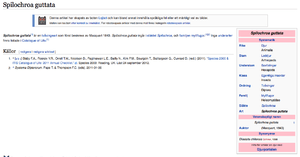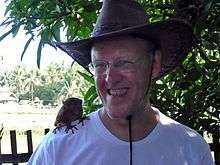Lsjbot
Lsjbot is an automated Wikipedia article-creating program, or Internet bot, developed by Sverker Johansson for the Swedish Wikipedia. The bot primarily focuses on articles about living organisms and geographical entities (such as rivers, dams, and mountains).
 A typical article generated by Lsjbot | |
| Developer(s) | Sverker Johansson |
|---|---|
| Type | Internet bot |
| Website | Lsjbot on Swedish Wikipedia |
According to its description page on the Swedish Wikipedia, Lsjbot was active in the Swedish Wikipedia and in the Cebuano and Waray Wikipedias, and has created most Wikipedia articles in those languages[1] (between 80% and 99% of the total[2]).
History

The program is responsible for 2.7 million articles as of July 2014, two thirds of which appear in the Cebuano language Wikipedia (the native language of Johansson's wife); the other third appear in the Swedish Wikipedia. The bot can produce up to 10,000 articles per day.
On June 15, 2013, the Swedish Wikipedia hit one million articles, the eighth language on Wikipedia to reach that goal. The millionth article was created by Lsjbot – which at that point had created 454,000 articles, almost half of the entire article count of the Swedish Wikipedia.[3] Lsjbot was also responsible for helping the Swedish Wikipedia become the second edition of Wikipedia to reach 2 million articles, which subsequently became the second largest edition of Wikipedia behind only its English counterpart.
In February 2020, Vice reported that Lsjbot was responsible for over 24 million of 29.5 million edits at Cebuano Wikipedia, now the world's second largest Wikipedia, with bots comprising all but five of the site's top 35 editors and no human editors in the top 10. However, Lsjbot is no longer creating new articles at the Cebuano, Swedish, and Waray-Waray Wikipedias. Sverker Johansson explained that "opinions shifted" within the Swedish Wikipedia community and Waray-Waray editors were unable to form a consensus about the automatic creation of articles.[4]
In the press
Its operation has generated some criticism, from those who suggest the stub articles lack meaningful content and a human touch.[5] The Sydney Morning Herald compared the bot to Phil Parker, allegedly the most published author in human history, who has published over 85,000 books, each of which is completed in less than an hour using computers.[6] Popular Science compared the bot to the announcement in July 2014 by the Associated Press that it planned to use bots to write articles.[7] Johansson countered attacks on his methods by noting that if the bot does not write articles, "otherwise they're mainly written by young, white, male nerds and reflect male interests."[8]
References
- The bot’s user page on the Swedish Wikipedia, translated to English using Google Translate.
- stats:EN/BotActivityMatrixCreates.htm
- Gulbrandsson, Lennart (17 June 2013). "Swedish Wikipedia surpasses 1 million articles with aid of article creation bot". Wikimedia Blog. Archived from the original on 24 February 2018. Retrieved 24 February 2018.
- Wilson, Kyle (11 February 2020). "The World's Second Largest Wikipedia Is Written Almost Entirely by One Bot". Vice. Retrieved 12 February 2020.
- Jervell, Ellen Emmerentze (13 July 2014). "For This Author, 10,000 Wikipedia Articles Is a Good Day's Work". Wall Street Journal. Archived from the original on 24 February 2018. Retrieved 24 February 2018.
- Bagshaw, Eryk (16 July 2014). "This is how Sverker Johansson wrote 8.5 per cent of everything published on Wikipedia". Sydney Morning Herald. Archived from the original on 24 February 2018. Retrieved 24 February 2018.
- Main, Douglas (14 July 2014). "This Bot Has Written More Wikipedia Articles Than Anybody". Popular Science. Archived from the original on 24 February 2018. Retrieved 24 February 2018.
- "Swedish Wiki vet sets new content record". The Local. 18 July 2014. Archived from the original on 24 February 2018. Retrieved 24 February 2018.
External links
- Source code of Lsjbot